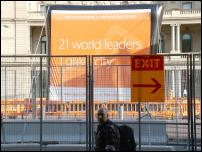APEC: Court Considers Movements Right To Protest
APEC 2007: Supreme Court Considers Movements Right To Protest
By Selwyn Manning in Sydney reporting on APEC
 APEC NEWS UPDATE: Protesters have been denied permission to march to the edge of police lines during an anti-APEC rally in Sydney on Saturday.
APEC NEWS UPDATE: Protesters have been denied permission to march to the edge of police lines during an anti-APEC rally in Sydney on Saturday.
The NSW Supreme Court today granted Police Commissioner Andrew Scipione's application for an order preventing up to 20,000 people from marching to the corner of George and King streets.
For more, See SMH: Police Win Protest Action
Scoop report continues: Members of the Stop Bush Coalition attended a New South Wales Supreme Court hearing Wednesday morning attempted in vain to stave off Police plans to prevent a protest march tracking through a high security zone on Saturday. (click on image for photo-essay.)
The NSW Police Commissioner Andrew Scipione sought a Supreme Court ruling that would prevent Saturday's anti-APEC march from walking down Sydney's Martin Place – the heart of the secure CBD area and the location of the United States Consulate, and a host of the city's top hotels where many of the 21 APEC leaders are staying.
The courtroom move was an attempt to further legitimise the Australian security forces want to keep those not involved directly with APEC well away from the annual leaders' summit.
NSW Police have been given special powers to "detain and question" protesters during the APEC leaders week. Throughout Wednesday through to Saturday Sydney-based Police are on the hunt for students and school truants.
Police are trawling through trains, buses, and city streets in pursuit of youths who they believe may have been recruited as scouts and spotters by protest movement organisers.
Sydney's CBD, particularly the area between George and Macquarie streets and leading up to Circular Quay and the Sydney Opera House, is in lock-down. The streets are now bordered with a protester-free-fence – a 2.8 metre high galvanized iron mesh fence. Steel gates have been erected at intersections within this secure grid, clearly the plan is to close a gate in front of protesters, close a gate behind, segregate portions of the protest off from the whole and hold indefinitely. The mesh fence also is able to keep people away from the roadway while motorcades shuttle leaders to and from meetings in the Sydney Opera House, Government House and Darling Harbour's convention centre.
The city is becoming increasingly quiet. That is likely to change on Saturday when more than 20,000 people will protest against APEC, US president George Bush's invasion and handling of Iraq, and Australia and the USA's want to push through their version of a solution to sustaining business and addressing climate change.
The protest organizers sought to march from the Sydney Town Hall, down George Street, through Martin Place to Hyde Park.
NSW Police Commissioner Andrew Scipione, claimed a manual published by a protest group gave advice to people on how to take "direct action" against those gathering at APEC and that it was a blueprint for violence. Police counsel said attacks were likely against public and private property, disorder and disruption to traffic.
The notion was countered by the protest movement who said Police had trumped up the claims in preparation for widespread arrests and planned detentions.
Justice Adams initially appeared sceptical of the police claims. "Direct action does not say violence to me," the judge was quoted as saying. "Violence is unlawful. I would not assume that people would need to take unlawful action."
The Police had tabled secret documents for the Supreme Court to consider.
Click here for Scoop's APEC FULL COVERAGE


 Peter Dunne: Dunne's Weekly - It's An Election, Not A Coronation
Peter Dunne: Dunne's Weekly - It's An Election, Not A Coronation Ian Powell: The Dirtiest Of Politics And A Tale Of Two MPs Cloaked In Hypocrisy
Ian Powell: The Dirtiest Of Politics And A Tale Of Two MPs Cloaked In Hypocrisy Gordon Campbell: On A Neglected, Enduring Aspect Of The Francis Era
Gordon Campbell: On A Neglected, Enduring Aspect Of The Francis Era Eugene Doyle: 50 Years After The “Fall” Of Saigon - From Triumph To Trump
Eugene Doyle: 50 Years After The “Fall” Of Saigon - From Triumph To Trump Lynley Tulloch: Pulling The Mat Out From Under The Early Childhood Education (ECE) Sector
Lynley Tulloch: Pulling The Mat Out From Under The Early Childhood Education (ECE) Sector Howard Davis: NZSQ Inaugurates Wellington Chamber Music’s New Season
Howard Davis: NZSQ Inaugurates Wellington Chamber Music’s New Season